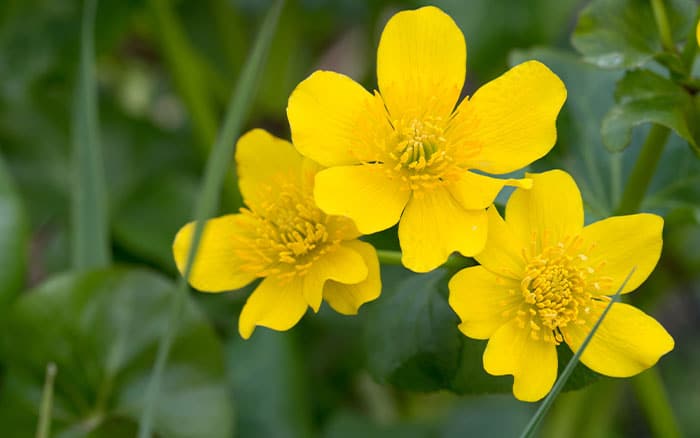Marsh Marigolds are a lovely flower to grow near your garden. Loving boggy or aquatic compost, it makes a wonderful and colourful feature to enjoy.
Why should you grow Marsh Marigold?

This wildflower is regularly found in nature, particularly damp spots such as meadows, marshes, ditches, and wet woodlands. It is one of Britain’s most ancient native plants and may have been here before the last Ice Age. Its hardiness and love of wet ground make it ideal for planting around your pond at home.
These plants are lovely for softening the border of your pond, with their heart-shaped dark green leaves. And because they love the boggy ground, you can plant them beyond the water’s edge.
This makes the border between your pond and your hard landscaping more seamlessly blended.
The Marsh Marigold is considered a valuable wildflower to grow in wetland nature reserves by the Wildlife Trusts.
It provides essential shelter for frogs and other amphibians, whilst also offering an early source of nectar for insects and pollinators.
Did you know?
The Marsh Marigold’s Latin name, Caltha, is derived from the Greek word for ‘goblet’. This is thanks to the golden cup shape that the flowers produce, which has earned this flower its other name, the Kingcup.
How to grow Marsh Marigold

Name: Caltha palustris (Marsh Marigold)
Position: Full sun or partial shade
Soil: Reliably moist or boggy, or aquatic compost
Depth of water: 0-5cm
Rate of growth: Average to fast
Flowering period: April
Hardiness: Fully hardy
Size: Eventual height = 0.4 metres; Eventual spread = 0.45 metres
Care: Low maintenance. Caltha will often regrow and flower again in autumn if cut back hard in the summer. Lift and divide large clumps in late spring.
Fun Fact
On the Isle of Man, the Marsh Marigold was considered a harbinger of good fortune. As it is one of the first flowers of the year, it is regarded as a herald of spring. And so, they are scattered over doorsteps on the eve of May Day. That is why it is also called the Mayflower.
So, add some colour and softening beauty to the edge of your pond with the Marsh Marigold. It will brighten up the space, and it has environmental benefits too.

Leave A Comment